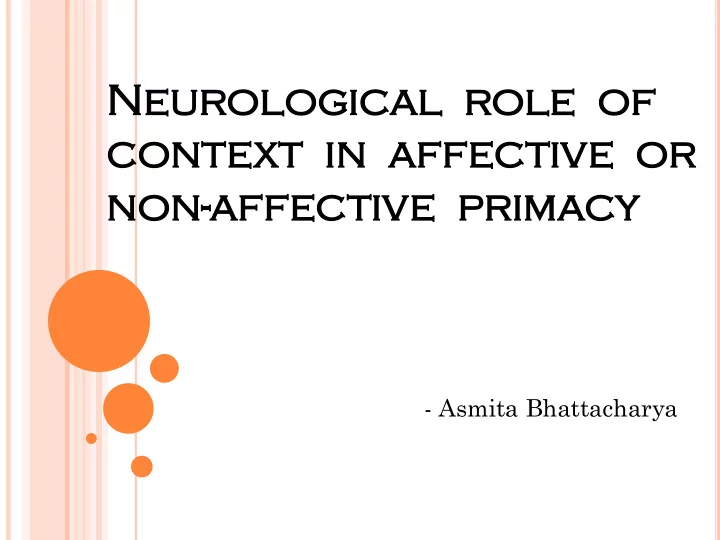

Neur urological ological rol ole e of of cont ontext xt in af affectiv fective e or or non on-affec affectiv tive e pr primacy imacy - Asmita Bhattacharya
AIM : OVERA L: To establish a neurological support for the Ad hoc RALL: cognition model. DONE SO FAR: To duplicate experiments as described in the paper discussed earlier, to establish context’s role in processing. TO DO NEXT EK: To image the brains of the subjects by T WEEK: functional magnetic resonance imaging ( fMRI) as the experiment is being done on them.
Ad hoc cognition : All categorizations, concepts and semantics are constructed ad hoc , whenever we use them Affective : emotional aspect, and non-affective: semantic aspect Relative speed with which affective/non-affective processing occurs in response to stimuli is context-dependent HYPO POTHE THESIS SIS : In affective context, the affective processing centres of the brain should show more activity, whereas in non-affective context, the non-affective processing centres of the brain should show more activity
Duplication of non-FMRI experiment : 8 subjects selected from among English speakers For each expt, 2 subjects were assigned to affective context group, and 2 to non-affective context group Task-Set-Inertia paradigm is used for context – alternating target and filler items Targets (Filler for Expt 2): 32 words of 4 categories : positive human ( princess ), negative human ( murderer ), positive animal ( rabbit ), negative animal ( cockroach ) Fillers (Target for Expt 2): 32 pictures of 4 categories : pleasant outdoor, pleasant indoor, unpleasant outdoor and unpleasant indoor Pre-test done to normalize the valence of the items used in the test, which were shown for 0.5 seconds The reaction time (RT) (verbal affective/non-affective judgment) was recorded for the targets
RESUL ULTS TS -I : Experiment 1 My result: Paper’s result: Experiment 1 Affective judgment 180 Non affective judgment 160 140 RT in centi-seconds 120 100 80 60 40 20 0 Affective context Non-affective context
RESUL ULTS TS -II : Experiment 2 My result: Paper’s result: Experiment 2 Affective judgment 180 Non affective judgment 160 140 RT in centi-seconds 120 100 80 60 40 20 0 Affective context Non-affective context
INFERENCES ERENCES : In experiment 1, as predicted, with affective contexts, affective judgments were made faster than non-affective ones; and with non- affective contexts, non-affective judgments were made faster than affective ones. In experiment 2, as predicted, with affective contexts, affective judgments were made faster than non-affective ones; however, with non-affective contexts, non-affective judgments were made faster than affective ones. The biasing towards affective judgment, predicted by authors of the paper while using picture stimuli, was not seen here, probably because of less sharp nature of images used. The overall idea was successfully reproduced in these experiments
PRO PROBLEMS LEMS : Error bars and average RT were much larger in my data than previous work, probably because of poorer measurement techniques The number of subjects used by me was only 8 whereas the authors had used around 40 subjects The sample set for target stimuli had 32 items in my data, whereas the authors had used 96 items The quality of images used by me was not very good (e.g., mainly pictures of pollution spills for “unpleasant outdoors” and hotel brochure photos for “pleasant indoors”) My own reaction time in using the stopwatch is also a confusing factor here, since reaction times of the average of ~0.70 seconds was being measured
REMA MAINING INING WORK : The final step involves repeating the experiment using the same target-filler set up while getting FMRI images of the subject’s brains To be done on 4-8 people on 20 th November at SGPGI, Lucknow The scan time is to be synchronized with the time lapse between the stimuli (i.e. effective reaction time) Full brain imaging is to be done, as areas to focus on are not clear Response to stimuli is to be a motor signal , and not speech, as speech entails greater processing (i.e. more noise) Occipital cortex noise is to be excluded from further analysis
Th Thank ank Y You ou
Recommend
More recommend